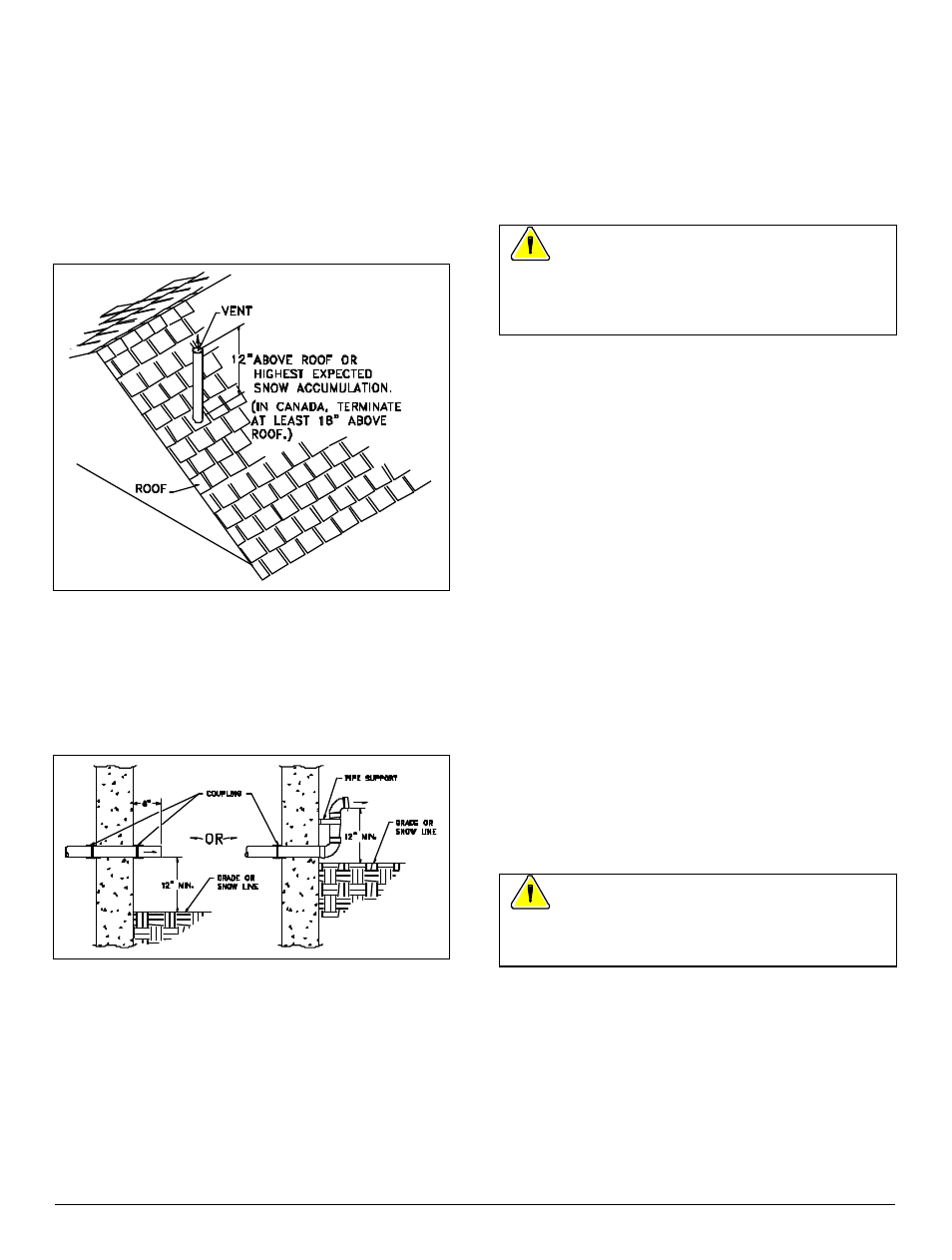Thermo Pride Thermo Pace Downflow/Horizontal Furnace (CSA) User Manual
Page 15

Installer’s Information Manual
Page 15
NON-DIRECT VENT TERMINATION
You may terminate vent pipe either vertically (through the
roof) or horizontally (through a sidewall). Vertical (through
the roof) venting is preferred because it offers protection
from pipe damage and is less likely to cause condensate
damage.
For vertical non-direct venting, extend PVC vent pipe at
least 12 inches above roof or average snow accumulation.
In Canada, vent pipe must extend at least 18 inches above
roof. See Figure 15.
Figure 15. Vertical Termination for Non-Direct Venting.
Note: When properly installed, vent system is designed to
drain condensate and will not be affected by rainwater.
For horizontal non-direct venting, extend PVC pipe at least
6 inches from structure and 12 inches above grade or
above average snow accumulation. See Figure 16.
Figure 16. Horizontal Termination for Non-Direct Venting.
COMBUSTION AND VENTILATION AIR (non-direct
vent)
The total amount of combustion and ventilation air provided
within the building must equal the requirements of all gas
appliances in the building. You must also allow for
reduction of air available for combustion and ventilation
caused by exhaust fans, range hoods and fireplaces.
Sufficient air must be provided to ensure there will not be a
negative pressure in fu rnace room or space. In addition,
there must be a positive seal between fu rnace and return-
air duct to avoid pulling air from furnace room.
Provide for adequate combustion and ventilation air in
accordance with Section 5.3, Air for Combustion and
Ventilation, of the National Fuel Gas Code, ANSI
Z223.1/NFPA 54, or Sections 7.2, 7.3 or 7.4 of CAN/CGA
B149 Installation Codes, or applicable provisions of local
building codes.
WARNING: Furnaces and any other fuel burning
appliances must have enough fresh air for proper
combustion. Lack of adequate combustion air could cause
the furnace to produce carbon monoxide and may result in
nausea or asphyxiation.
Excessive exposure to air contaminated with chlorine,
fluorine, bromine and iodine may result in safety and
performance related problems. The following types of
installation may require outdoor air for combustion (or direct
venting) due to chemical exposures:
??
Commercial buildings, repair garages, beauty parlors,
and so on
??
Buildings with indoor pools
??
Furnaces installed in laundry rooms
??
Furnaces installed in hobby or craft rooms
??
Furnaces installed near chemical storage rooms
??
Furnaces installed near exhaust fans which vent the
above areas
Exposure to the following substances in the combustion air
supply may also require outdoor air for combustion:
??
Aerosols
??
Permanent wave solutions
??
Chlorinated waxes, bleaches a nd cleaners
??
Cat litter
??
Chlorine-based swimming pool chemicals
??
Cleaning solvents
??
Paint removers and varnishes
??
Adhesives
??
Anti-static fabric softeners
??
Most refrigerants
WARNING: Combustion air that contains chlorine,
fluorine, bromine or iodine could cause corrosion in heat
exchanger and may result in nausea or death by
asphyxiation.
UNCONFINED SPACE INSTALLATION (non-direct
vent)
The National Fuel Gas Code, ANSI Z223.1/NFPA 54 and
CAN/CGA B149 Installation Codes do not require that you
m ake special provisions for combustion and ventilation air
when furnace is in an "unconfined space" and building is
not of "unusually tight construction".
??
"Unconfined spaces" have a volume of at least 50
cubic feet per 1000 Btu per hour combined input rating
